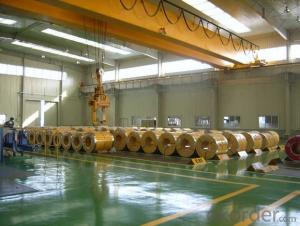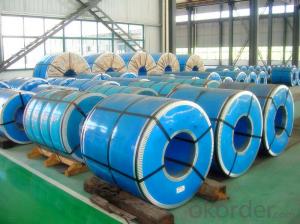Hot Rolled Stainless Steel Coil 304 No.1 Finish Narrow Strip
OKorder Service Pledge
OKorder Financial Service
You Might Also Like
Type | Hot Rolled Stainless Steel Coil 304 Narrow Strip |
Thickness | 2.5mm-4.0mm |
Width | 550mm, 650mm |
Length | according to weight |
Brand name | CNBM |
Standard | ASTM, AISI, DIN, GB, JIS etc |
Material | 304 |
Application | Foodstuff, Gas, metallurgy, biology, electron, chemical, petroleum, boiler, nuclear energy, Medical equipment, fertilizer etc |
Package | Standard export sea-worthy packing |
Delivery time | Within 15 days since getting the deposit or LC origin |
Surface | NO.1 |
Productivity | 20000 tons/month |
Hot Rolled Stainless Steel Coil 304 Chemical Composition:
(%):C=0.07, Mn=2.00, P=0.045, S=0.030, Si=0.075, Cr=17.5-19.5, Ni=8.0-10.5, N=0.10
Hot Rolled Stainless Steel Coil 304 Physical Properties
Tensile strength σb (MPa) ≥ 520
The conditions yield strength σ0.2 (MPa) ≥ 205,
Elongation δ5 (%) ≥ 40
Reduction of ψ (%) ≥ 50,
Hardness: ≤ 187
HB; ≤ 90
HRB; ≤ 200H
- Q:How do you remove scratches from stainless steel strips?
- To remove scratches from stainless steel strips, you can try a few methods: 1. Start by cleaning the surface with warm soapy water and a soft cloth. This will help remove any dirt or grime that may be masking the scratches. 2. Use a non-abrasive stainless steel cleaner or a mixture of baking soda and water. Apply the cleaner to a soft cloth and gently rub it onto the scratched area in a circular motion. Be sure to follow the grain of the stainless steel to avoid further damage. 3. For deeper scratches, you can use a stainless steel scratch remover or a metal polishing compound. Apply a small amount of the product onto a clean cloth and rub it into the scratch using a circular motion. Continue rubbing until the scratch fades or disappears. Make sure to wipe off any excess product and rinse the area with water. 4. Another option is to use a fine-grit sandpaper or a stainless steel polishing pad. Start with a lower grit sandpaper (around 400) and gently rub it over the scratch in the direction of the grain. Gradually move to higher grit sandpaper (800, 1000) for a smoother finish. Remember to clean the surface afterwards to remove any residue. 5. If the scratches are too deep or extensive, it may be necessary to hire a professional to repair or replace the stainless steel strips. Remember to always test any cleaning or polishing method on a small, inconspicuous area first to ensure it doesn't cause any damage.
- Q:What are the differences between hot-rolled and cold-rolled 111 stainless steel strips?
- The production processes and resulting characteristics of hot-rolled and cold-rolled 111 stainless steel strips differ significantly. Hot-rolled strips are created by subjecting the stainless steel to high temperatures and passing it through rollers to achieve the desired thickness. This method produces a material that is more malleable and ductile, making shaping and forming easier. The resulting strips have a rougher surface finish and a scaled oxide layer, which can be eliminated through additional processing if desired. Additionally, they tend to have a larger grain structure, resulting in less precise and more variable dimensional tolerance. Conversely, cold-rolled strips undergo further processing after being hot-rolled. This involves passing them through a series of rollers at room temperature, resulting in a smoother surface finish and a more precise dimensional tolerance. These strips have a finer grain structure and a more uniform thickness, making them ideal for applications that require precision and consistency. In terms of mechanical properties, hot-rolled strips generally exhibit higher yield and tensile strengths compared to cold-rolled strips due to strain hardening during the hot-rolling process. However, cold-rolled strips have better surface quality and improved flatness due to additional processing steps. To summarize, hot-rolled stainless steel strips are more malleable with a rougher surface finish, while cold-rolled strips offer better dimensional precision, surface quality, and flatness. The choice between the two depends on specific application requirements, such as the need for shaping, precision, or surface aesthetics.
- Q:Can stainless steel strips be used in harsh weather conditions?
- Stainless steel strips are capable of withstanding even the harshest weather conditions. Renowned for its outstanding resistance to corrosion, stainless steel is highly impervious to rust and other forms of deterioration caused by exposure to moisture, humidity, and extreme temperatures. Consequently, stainless steel strips prove to be a dependable and long-lasting choice for various applications that experience adverse weather, such as outdoor structures, building facades, roofing, and marine environments. The corrosion resistance of stainless steel can be attributed to the presence of chromium within its composition, which creates a protective layer on the metal's surface, preventing it from reacting with the surrounding environment. Moreover, stainless steel also possesses resistance to UV radiation and can endure strong winds, making it a suitable option for regions prone to storms and hurricanes. In conclusion, stainless steel strips offer an outstanding solution for applications that necessitate strength, durability, and the ability to withstand harsh weather conditions.
- Q:Can stainless steel strips be used in the food processing industry?
- Yes, stainless steel strips can be used in the food processing industry. Stainless steel is highly resistant to corrosion, easy to clean, and does not react with food or alter its taste. This makes it an ideal material for equipment, machinery, and tools used in food processing, ensuring hygienic and safe production processes.
- Q:Can stainless steel strips be used for decorative screens?
- Yes, stainless steel strips can be used for decorative screens. Stainless steel is a versatile material that offers durability, resistance to corrosion, and a sleek, modern appearance, making it suitable for creating decorative screens in various settings such as homes, offices, or public spaces.
- Q:What is the impact resistance of stainless steel strips?
- Stainless steel strips possess exceptional impact resistance as a result of their intrinsic characteristics and distinctive production method. The remarkable impact resistance of stainless steel strips stems primarily from their elevated tensile strength and toughness. Stainless steel, an amalgam comprised of iron, chromium, and additional elements such as nickel, molybdenum, and manganese, acquires enhanced mechanical properties, including substantial strength and ductility, from these constituents. Consequently, stainless steel strips can endure external forces and impacts without succumbing to deformation or breakage. Furthermore, the manufacturing process of stainless steel strips entails subjecting them to a technique known as cold rolling. During this procedure, the stainless steel is passed through a sequence of rollers at low temperatures, thereby augmenting its strength and hardness. This subsequent step further bolsters the impact resistance capabilities of stainless steel strips. The impressive impact resistance demonstrated by stainless steel strips renders them highly suitable for a diverse range of applications requiring durability and resilience against external forces. Industries such as automotive, construction, aerospace, and marine extensively utilize these strips, as they are frequently exposed to harsh conditions and potential impacts. In conclusion, the combination of high tensile strength, toughness, and the cold rolling process during production ensures that stainless steel strips exhibit exceptional impact resistance. These qualities make stainless steel strips an exceedingly reliable choice for applications necessitating resilience against external forces and impacts.
- Q:Can stainless steel strips be used in the pharmaceutical equipment industry?
- Stainless steel strips are indeed applicable in the pharmaceutical equipment industry. Due to its exceptional resistance to corrosion, remarkable strength, and hygienic characteristics, stainless steel is widely favored in this sector. Numerous elements of pharmaceutical equipment, such as storage tanks, mixing vessels, piping systems, and conveyors, are frequently fabricated using stainless steel strips. The smooth and easily cleaned surface of stainless steel is perfect for upholding stringent cleanliness standards and preventing contamination during pharmaceutical manufacturing procedures. Moreover, stainless steel is highly enduring and capable of withstanding the harsh conditions commonly encountered in pharmaceutical manufacturing facilities. Consequently, stainless steel strips represent a dependable and appropriate material for utilization in the pharmaceutical equipment industry.
- Q:Are stainless steel strips resistant to crevice corrosion?
- Yes, stainless steel strips are generally resistant to crevice corrosion due to their inherent corrosion-resistant properties.
- Q:Can stainless steel strips be magnetized?
- Stainless steel strips can indeed be magnetized. Although stainless steel is typically regarded as non-magnetic, certain varieties of stainless steel can display magnetic characteristics under specific circumstances. The magnetic attributes of stainless steel are influenced by factors such as its chemical composition, heat treatment, and manufacturing process. The most commonly found type of stainless steel, known as austenitic stainless steel, is generally non-magnetic. Nevertheless, it can acquire a slight magnetic quality when subjected to cold working or deformation, as is the case with stainless steel strips. Conversely, ferritic and martensitic stainless steels possess magnetism in their annealed or hardened state. These particular types of stainless steel strips can be easily magnetized and retain their magnetism even after the external magnetic field is no longer present. Consequently, it is crucial to take into account the specific type of stainless steel strip in order to determine its magnetic properties.
- Q:Can stainless steel strips be used in oil and gas industries?
- Indeed, the oil and gas industries can utilize stainless steel strips. Renowned for its exceptional resistance to corrosion, impressive strength, and long-lasting nature, stainless steel proves to be an optimal material for various applications within the oil and gas sector. By employing stainless steel strips, one can manufacture pipes, tubes, fittings, valves, heat exchangers, and other components that encounter challenging operational conditions such as corrosive surroundings, elevated temperatures, and intense pressures. Moreover, stainless steel boasts commendable weldability and formability, thereby enabling effortless fabrication and installation in oil and gas facilities. In summary, stainless steel strips offer the essential dependability and performance that the oil and gas industry necessitates.
1. Manufacturer Overview |
|
|---|---|
| Location | |
| Year Established | |
| Annual Output Value | |
| Main Markets | |
| Company Certifications | |
2. Manufacturer Certificates |
|
|---|---|
| a) Certification Name | |
| Range | |
| Reference | |
| Validity Period | |
3. Manufacturer Capability |
|
|---|---|
| a)Trade Capacity | |
| Nearest Port | |
| Export Percentage | |
| No.of Employees in Trade Department | |
| Language Spoken: | |
| b)Factory Information | |
| Factory Size: | |
| No. of Production Lines | |
| Contract Manufacturing | |
| Product Price Range | |
Send your message to us
Hot Rolled Stainless Steel Coil 304 No.1 Finish Narrow Strip
OKorder Service Pledge
OKorder Financial Service
Similar products
New products
Hot products
Related keywords






























